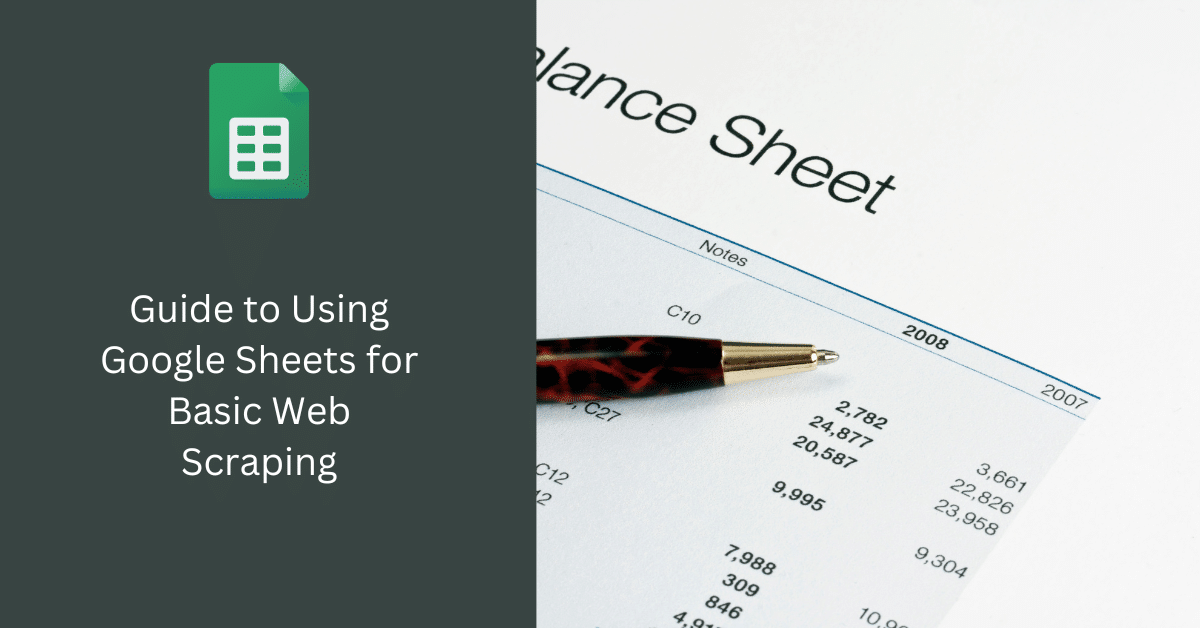
In today’s data-driven world, information is power, and harnessing data from the web has become an essential skill. Google Sheets, a widely used spreadsheet tool, offers a powerful feature called IMPORTXML, which allows you to scrape data from websites and import it directly into your spreadsheets. In this comprehensive guide, we’ll walk you through the process of using Google Sheets for basic web scraping, empowering you to gather valuable data effortlessly.
Importing XML and HTML
Before we dive into web scraping with Google Sheets, it’s essential to understand the basics of XML and HTML. These are the two primary markup languages used on the web. XML (eXtensible Markup Language) is used for structuring data, while HTML (HyperText Markup Language) is used for structuring web content.
Google Sheets uses IMPORTXML to retrieve data from websites by interpreting the XML or HTML elements. You can import data like prices, stock information, or any other structured data you find on web pages.
How IMPORTXML works
IMPORTXML is a built-in function in Google Sheets that extracts data from a specified URL using XPath queries. XPath is a language for navigating XML documents and selecting nodes from them.
To use IMPORTXML, you need to provide two arguments: the URL of the webpage you want to scrape and the XPath query that points to the specific data you want to extract. Google Sheets then fetches the data and displays it in your spreadsheet.
Quick XPath introduction
XPath is a powerful tool for selecting data from an XML or HTML document. It uses path expressions to navigate through elements and attributes in an XML/HTML document. Here’s a brief example:
Let’s say you want to extract the title of a webpage. The XPath query for this would be:
//title
This query tells Google Sheets to find all <title> elements on the page.
How to extract data from a website to Google Sheets

Now, let’s get our hands dirty and perform some web scraping with Google Sheets:
- Open a new Google Sheets document.
- Enter the website URL you want to scrape data from.
- Click on a cell in your spreadsheet.
- Type =IMPORTXML(“URL”, “XPath Query”), replacing “URL” with the webpage URL and “XPath Query” with your desired query.
- Press Enter, and watch the magic happen!
Google Sheets will fetch the data from the website and display it in the selected cell.
Google Sheets offers more than just IMPORTXML. You can enhance your web scraping skills by exploring other related functions like IMPORTHTML and IMPORTDATA. These functions allow you to import data from HTML tables and CSV files, respectively, making your data acquisition process even more versatile.
Import a table from a website to Google Sheets
Importing tables from websites into Google Sheets is a breeze. Here’s how:
- Identify the table: Visit the webpage with the table you want to import and right-click on it. Select “Inspect” to open the developer tools and locate the HTML code that represents the table.
- Use IMPORTHTML: In your Google Sheets document, enter the following formula:
=IMPORTHTML(“URL”, “table”, index)- “URL” should be the webpage’s URL.
- “table” specifies that you want to import a table.
- “index” is the position of the table on the webpage (use 1 if it’s the first table).
- Press Enter. Google Sheets will import the table, making it readily available for analysis and manipulation.
Import data from XML feeds to Google Sheets
XML feeds are a common source of dynamic data. To import data from XML feeds into Google Sheets:
- Get the XML feed URL: You’ll need the URL of the XML feed you want to import.
- Use IMPORTXML: In a cell, enter:
=IMPORTXML(“XML feed URL”, “XPath Query”)- “XML feed URL” is the URL of the XML feed.
- “XPath Query” should specify the data you want to extract.
- Press Enter. Google Sheets will pull data from the XML feed and display it in your spreadsheet.
Customizing data imported by IMPORTFEED
IMPORTFEED is a versatile function that allows you to import data from various feeds, such as RSS. To customize imported data:
- Use the “element” parameter: By default, IMPORTFEED imports the most recent feed item. To customize it, add the “element” parameter. For example:
=IMPORTFEED(“RSS feed URL”, “element”, num)- “RSS feed URL” is the URL of the RSS feed.
- “element” specifies the element you want (e.g., “title” or “description”).
- “num” determines the item number (1 for the most recent, 2 for the second most recent, and so on).
Importing Data from CSV to Google Sheets

CSV (Comma-Separated Values) files are widely used for data exchange. To import data from a CSV file into Google Sheets:
- Open Google Sheets.
- Click on “File” > “Import.”
- Upload your CSV file.
- Configure import settings: You can specify how Google Sheets should handle the data, including delimiter settings and data formatting.
- Click “Import.” Google Sheets will create a new sheet with the imported data.
Does the data stay fresh?
Data imported using these functions does not update automatically. To keep the data fresh, you need to manually refresh it. Right-click on the cell containing the import function and select “Refresh.” You can also set up automated triggers to refresh data at specific intervals.
Advantages and drawbacks of import functions
Advantages:
- Ease of use: Import functions in Google Sheets are user-friendly and don’t require coding skills.
- Versatility: You can import data from various sources, including websites, XML feeds, and CSV files.
- Automation: With Google Apps Script, you can automate data refresh and processing.
Drawbacks:
- Data freshness: Data doesn’t update automatically, which can be a drawback for real-time data needs.
- Website changes: If a website’s structure changes, your import functions may break, requiring updates.
- Volume limitations: Google Sheets has limitations on the amount of data you can import and process.
Common Errors
When using import functions, you might encounter errors. Common ones include:
- #N/A: This error occurs when the XPath or query you provided doesn’t match any data on the webpage or feed.
- #REF!: It indicates a reference error, usually because the source data moved or was deleted.
- #ERROR: This is a general error message that can result from various issues, including incorrect syntax or exceeding import limits.
In such cases, double-check your formulas, XPath queries, and data sources to resolve the errors.
In this guide, we’ve demystified the art of web scraping using Google Sheets. You’ve learned how to import XML and HTML, how IMPORTXML works, the basics of XPath, and the process of extracting data from websites to Google Sheets. Armed with this knowledge, you can collect valuable data for research, analysis, or any other purpose with ease.
Now, it’s time for you to explore the world of web scraping and unlock the potential of data at your fingertips. Happy scraping!





